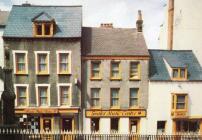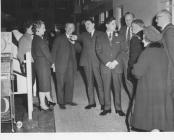Content can be downloaded for non-commercial purposes, such as for personal use or in educational resources.
For commercial purposes please contact the copyright holder directly.
Read more about the The Creative Archive Licence.
Description
Denomination: Anglican
Dedication: St John the Baptist
Built: 1852
Photography: John Ball
Date: 13 June 2004
Camera: Fuji FinePix S602 Zoom digital
Note 1: St John's church is located on the west side of the Afon Taf in a prominent position on the north side of Cwmdu Road, close to its junction with Hill Street. It was built in 1850-1 to designs of architect John Pritchard of Llandaff, partly at the expense of Anthony Hill who was the owner of nearby Plymouth Ironworks. The church was a chapel of ease to Merthyr Tydfil, but became a parish church by 1860, the parish then known as Pentrebach parish but the church called Pontrhun church, Pentrebach and Troedyrhiw being strictly the other side of the river. The intention was to build a cruciform church, but only a short projection was built on the site of the north transept. There was a painted frieze around the chancel. The church was built in early Gothic style with a High Victorian severity of line, and lancets throughout in various combinations. It is built of snecked sandstone with Bath stone dressings, the transept rock-faced. Its plan consists of nave and long chancel under a continuous roof, south transept, gable of unbuilt north transept, south porch, north-east vestry and west bellcote (continues as Note 2, below). [Source: Coflein Database NPRN 13321 (accessed 6 Sep 2015)]
Image 2:
Southeastern aspect of St John's Church.
Note 2: (continued from Note 1, above) The interior is tall and spacious with south transept and north transept gable (intended to be removed for full transept if funds allowed) and plastered walls, with dominant open truss roofs with high collars and deep arched braces: five main trusses to nave, four to chancel, two to south transept and one to north transept. The nave has corbels to main trusses and intermediate trusses without the bracing, the chancel roof is slightly higher and narrower.
Fittings include a large and ornate later nineteenth-century Gothic pine organ case in the south transept with painted pipes; an ashlar octagonal font chamfered top and bottom to deep bowl on quatrefoil squat column; hexagonal timber pulpit with cusped traceried blind panels and angle buttressing; and timber reredos with painted texts of Lords Prayer, Ten Commandments and Creed. Stained glass includes works by William Wailes. Anthony Hill insisted that only he be buried within the church, and he is interred under the chancel in three coffins of yew, oak and lead. [Source: Coflein Database NPRN 13321 (accessed 6 Sep 2015)]
Image 3:
Nave and chancel










Do you have information to add to this item? Please leave a comment
Comments (0)
You must be logged in to leave a comment